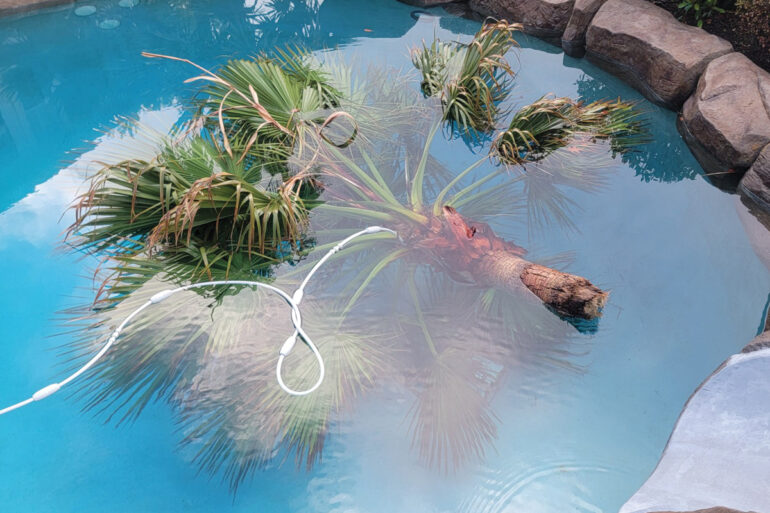Lessons in Lifting

Importance of servicing pool lifts
A pool service tech is often required to be a chemist, an engineer and a mechanic, all at once. It’s a job that is paramount to keeping swimmers and property safe — nowhere is that truer than in the case of servicing pool lifts. Typically used to help people with disabilities experience the benefits of a swimming pool, lifts must also keep the swimmer safe.
Pool lifts are designed to lower a seated person in or out of the water, which can be helpful for someone who lacks the mobility to climb a ladder or steps.
In 2013, rules were added to the Americans with Disabilities Act requiring pool lift or ramp access at most pools for public use or rental. This includes recreation centers, hotels, motels, private residential communities, nursing homes and other businesses. As part of adhering to this rule, a pool lift requires regular maintenance to ensure it’s working properly. Facilities that fail to comply can face civil penalties of up to $55,000.
Fortunately, according to Tom Gill, regional sales manager for Aqua Creek Products, servicing a pool lift doesn’t have to be complicated.
“The biggest thing is making sure the batteries are charged,” Gill says. “And then there’s not a lot that really goes wrong with them.”
The reason, Gill explains, is that pool lifts only have a handful of components, which is by design. Twenty-years ago, there were pool lifts powered by water, but battery-powered pool lifts were found to be easier to maintain and make up the majority of pool lifts sold today. “When you’re working with disabled kids, it’s hard to ask them to take a water powered lift out of the pool and replace valves,” Gill says. “Whereas with the battery systems, we’re able to do that with plug-and-play replacements.”
Aqua Creek Products manufactures aquatic access equipment, including pool lifts, out of Missoula, Montana. Aqua Creek’s pool lifts are battery-powered, with some batteries charged by solar energy and others with an outlet. The ease of maintaining the battery-powered lifts has been particularly helpful for the increased number of private homeowners Aqua Creek has seen take interest in pool lifts since the start of the pandemic.
“It’s really unbelievable the amount of [homeowners] who were taking their mom and dad out of nursing homes,” Gill says. “Our lifts are often used for the active aging community, so baby boomers and their parents.”
According to Gill, many of his customers wanted to outfit their homes with the same kind of pool lifts their parents used in their nursing homes. He understands the urgency, noting that for some people, the pool lift provides something more important than just recreation — a sense of agency. “This generation can buy a swim spa or pool, but worry about how to get in and out of it.”
Besides ensuring the pool lift has a fully charged battery, another often overlooked maintenance tip is checking that all the ports in the pool lift are properly plugged in. Unplugging and re-plugging them will do the trick. “Nine times out of 10, that fixes it,” Gill says.
Additionally, Gill notes that maintenance workers servicing a pool lift should keep in mind that many facilities, like hotels, have more than one pool lift available. So if one lift is acting strangely, swapping it out with a second lift can help troubleshoot what may be the cause of the problem. “You can always interchange electronics between the two models and figure out exactly what needs to be replaced,” Gill explains. “If it’s a rotating lift, you can switch the ports and try rotating it with a different button to see if it’s actually the motor or if it’s the handset giving you trouble.”
After five years of servicing pools and pool equipment, Brad Pilcher, a mobility specialist with 101 Mobility in Phoenix, Arizona, feels confident he can ascertain a problem with a pool lift even with his eyes closed. “Some noises are beneficial,” he says. “If the lift’s moving in the down direction and you hear chattering or anything coming from the actuator, you know it’s going out soon. You can actually hear tone differences when the batteries are low in amperage.”
Pilcher makes sure to keep a backup set of batteries in his van, so he can replace the battery for a customer quickly. He also carries a control box and remote to help him test equipment on-site. “With those three bits of equipment, I can narrow any repair that’s needed with 99% accuracy,” Pilcher says.
Pilcher recommends keeping any battery that isn’t in use on its charger and doing regular maintenance visits every couple of weeks to keep the battery in optimal condition.
He also advises running a battery through a full cycle before use, adding “By doing so, you’re going to verify that everything is working right, and by getting the chair actually in the water, you’re going to cool off the seat.”
Another important factor to keep in mind, are what Elliot Ball, commercial product manager at S.R. Smith, describes as potential “failure points.” Ball suggests making certain that lifts are rotating, rising and lowering correctly. “There aren’t that many failure points,” Ball says. “You’re going to have a failure point in the battery, or in your actuator, which is like the hydraulic part of it, or you’ll have a failure point with the control unit. But outside of those three things, there’s not much else that you’ll have an issue with.”
S.R. Smith was founded in 1932 as a small diving board company, before developing into a manufacturer of diving boards, rails, slides and pool lifts with a worldwide customer base. The Canby, Oregon-headquartered business, which is now owned by Fluidra, did not begin manufacturing pool lifts until 2012, just before the ADA rule change.
For the most part, a pool lift battery should last roughly 90 cycles under a full 350-pound load, before needing a recharge, and three-to-four years before needing to be replaced. However, Ball points out, a battery’s life, like anything, often comes down to proper care. “Keeping it clean, doing routine maintenance, checking the battery and making sure the battery is charged,” Ball says. “It is not just a compliance issue, but it’s also for the longevity of the lift.”
While a battery can’t last forever, memories can. “We work with the Make-A-Wish Foundation and … That’s where our heart is,” Gill says. “It is getting people in the pool so that they can improve their lives.”
Watch “How to Properly Maintain Your Lift” by Aqua Creek Products at bit.ly/3WPF8fq





